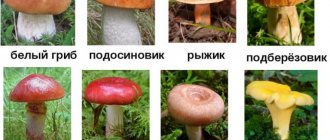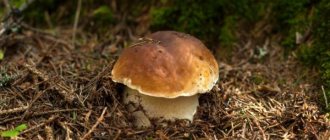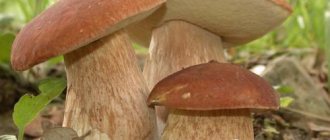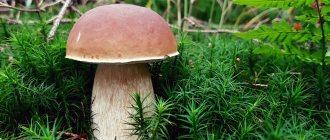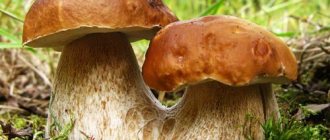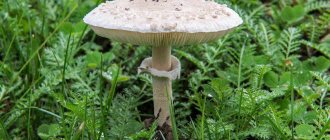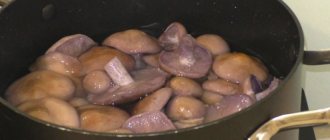Nature is multifaceted and there is a great diversity of all kinds of animals, plants and microorganisms. However, there is one unique kingdom, unlike all the others, combining the characteristics of both plants and animals - these are mushrooms. Their classification is very extensive and ambiguous. They are divided according to various criteria. The most valuable among them are category 1 mushrooms.
Edible and conditionally edible mushrooms
Edible mushrooms are divided into 4 categories. The difference factors are their nutritional value and the presence of harmful and toxic substances in them:
Category I - edible mushrooms of excellent taste - these are those mushrooms that can be eaten without harm to our health. They do not contain toxic substances and are usually very tasty.
The categories are indicated in the table (list) of mushrooms below. Those that do not have a category are not included in the official classification sources.
Category II – edible mushrooms of good taste.
Category III - conditionally edible - these are those mushrooms that cannot be eaten raw, but only after careful heat treatment. As a rule, they are lower in taste and useful qualities than edible mushrooms. By clicking on the link you will learn about the rules for pre-processing each mushroom of interest, as well as get acquainted with the most common and popular recipes for their preparation.
Category IV – conditionally edible mushrooms
It must be remembered that edible and conditionally edible mushrooms must be properly prepared, pickled, dried, stored and observed all the measures and rules provided for this or that mushroom. In addition, there are many dangerous mushrooms - look-alikes that look like edibles but are not. It is also worth studying all the rules for assembling and identifying edible mushrooms, and being very careful.
List of the most common edible and conditionally edible mushrooms:
A
- Golden Aleuria (Aleuria aurantia)
- Auricularia auricula-judae
B
- White steppe mushroom (Pleurotus eryngii)
- White mushroom (Boletus edulis)
- White oak mushroom (Boletus aereus bull)
- White birch mushroom (Boletus betulicola)
- White webweed (Leucocortinarius bulbiger)
- Boletinus paluster
- Boletinus polypeduncle
- Veined fishweed (Disciotis venosa)
- Rose red saucer (Discina Perlata)
IN
- Valuy (Russula foetens)
- Valuy
- Veselka vulgaris
- Oyster mushroom (pulmonary, carob, oyster)
- Volnushka (white, pink)
- Volvariella silky
- Funnel funnel-shaped
G
- Talker
- Golovach
- Hygrofor
- Gruzd
D
- Common dubovik
E
- Blackberry yellow
Z
- Winter mushroom
- Variegated umbrella
L
- Lyophyllum elm
- Chanterelles
- Pink lacquer
M
- May mushroom
- Spruce weed
- Mokruha pine
- Oiler
- Mosswort
ABOUT
- Honey mushrooms
P
- boletus
- Boletus
- Petsitsa
- Pluteus deer
- Caesar mushroom
- Semi-white mushroom
- Early field grass
- Float white
- Gossamer violet
- Milkman
- Cobweb
- Pluteus lion-yellow
- Porkhovka
- Polish mushroom
R
- Ryzhik
WITH
- Sparassis curly
- Russula
- Serushka
T
- Birch polypore (Birch sponge)
- Sheep polypore (Albatrellus ovine)
- Truffle
H
- Golden scale
Sh
- Champignon
- Shiitake
Classification according to the structure of the hymenophore
All mushrooms, regardless of the amount of harmful substances in their composition, are divided into groups according to the type of structure, external characteristics and a number of other criteria. Thus, according to the structure of the hymenophore, which is the part of the fruiting body that carries spores, the following types of organisms are distinguished:
- Lamellar. The hymenophore is represented by thin plates extending from the center of the cap to its edges. There are disputes between them.
- Marsupials, or smooth. The stem and cap of this species have practically no differences, and the spores are in a special bag, from which the group got its name.
- Tubular. Representatives of the group have so-called tubes under their caps, located perpendicularly. It is in these smallest parts that fungal spores are located.
- Folded. The spores are located in radical folds or deep wrinkles, which makes this group similar to the lamellar species.
Cap mushrooms, as a rule, have a lamellar hymenophore, so it is most likely to encounter a similar type during a “quiet hunt”. These include such popular representatives as champignons, russula and milk mushrooms. Even the well-known fly agaric also has a lamellar hymenophore. But the most expensive mushroom, the truffle, belongs to the group of marsupials. Porcini and boletus mushrooms are a type of fruit with a tubular hymenophore.
Inedible mushrooms
A
- Aleuria orange
- Askokorine meat
B
- Bolbitus aureus
G
- Gebeloma
D
- Discina thyroid
TO
- Kollibia
L
- False chanterelle
M
- Lactarius spinosulus
ABOUT
- Honey fungus brick-red
P
- Podvishen
- Porchowka blackening
- Pepper mushroom
- Field worker is tough
- Common liverwort
R
- Rogatik reed
- Ryadovka
WITH
- Violin
T
- tinder
H
- Tea mushroom
- Black milk mushroom
Second category
1. Boletus. This mushroom has a brown cap with a diameter of 5 to 28 cm, but with shades of orange and red. The leg can be high, from 4 to 18 cm, gray or off-white. The pulp is fleshy, at first white when cut, and then becomes bluish, and later turns completely black. It is found from June to October in deciduous or mixed forests, does not grow near coniferous trees, more often near aspens, birches, poplars and oaks.
2. Boletus. The boletus has a cap with a diameter of 4 to 12 cm, gray or brown, sometimes brown or almost black, a greyish leg with scales. It is confused with gall fungus. You can distinguish them by the pulp at the cut site; in the gall mushroom it turns red over time, but in the boletus it remains white. It is collected from the end of June to November, most often in deciduous forests, near birch trees.
3. Ordinary oiler. It has a cap with a diameter of 4 to 16 cm, it can be chocolate, brown, or yellow-brown in color. The leg is up to 12 cm, slightly lighter than the cap, yellowish. Often damaged by worms. Harvested from late September to late October. They love sandy soil, so they often grow near pines, oaks and birches.
Poisonous mushrooms
B
- Death cap
- Bjorkandera singed
IN
- fiberglass
AND
- Gall mushroom (gorchak)
TO
- Kalocera adhesive
- Konocibe
- Cordyceps
- Chestnut umbrella
L
- False raincoat
- False foam
M
- fly agaric
ABOUT
- Honey fungus sulfur-yellow
- Alder moth
R
- Poisonous rower
WITH
- Satanic mushroom
- Ordinary stitch
- Pig is not edible
H
- Silverfish
Sh
- Red champignon
E
- Entoloma poisonous
First category
1. White mushroom. It is also called boletus. It has a tall thick stem up to 25 cm, barrel-shaped, the cap is reddish, sometimes almost white. It grows almost everywhere. It is confused with gall or satanic mushroom. Can be collected from mid-July to September, most often found in the forest, among old trees.
2. Real breast milk. It is also called white milk mushroom. It has a short leg and a wide white cap, which sometimes grows up to 20 cm. The pulp has a pleasant fruity smell. It is not so easy to find, but if one mushroom has grown, there should be more nearby; it grows in groups. Collected in summer, from July to September, in deciduous or mixed forests. Suitable for pickling.
3. Ginger is real. Other names are pine or autumn saffron milk cap. It has an orange-red cap with a diameter of 5 to 15 cm, which is supported by a stalk 3-7 cm long. The stalk is hollow inside. The pulp is orange, green at the break. It produces an orange milky juice that turns green in the air; it is not hot. They are collected from June to October, both in coniferous and deciduous forests, as well as in clearings. It also grows in families, but hides in thick grass. Often used for pickling.
Third category
1. White wave. It has a fleecy cap from 4 to 8 cm; there are also large mushrooms with caps up to 12 cm, which have a small depression in the middle; over time they become like a funnel. They have a sweetish smell. The leg is short, up to 4 cm, white or slightly pink. It is collected from August to September in deciduous forests, often near birch trees.
2. The honey fungus is real. It is also called autumn. Honey mushrooms have small caps up to 10 cm, sometimes up to 15 cm, yellow or brown, the flesh smells delicious, tastes sour. They are found from August to October and grow on trees.
3. Moss fly green. It has a greenish-gray or olive cap with a diameter of 4 to 12 cm, velvety to the touch. The flesh is white, turning slightly blue at the cut site. Grows from mid-May to late September in all types of forests.
Is it possible to determine the toxicity of a mushroom when cooking?
There is an opinion that mushrooms can be tested for toxicity in the old fashioned way. To do this, use white onions and garlic. Mushrooms are poured with boiling water and cooked for about half an hour along with vegetables. If during cooking the garlic clove darkens and the onion acquires a bluish tint, it means that there are poisonous specimens among the mushrooms.
In fact, vegetables darken from tyrosine, which may be present in edible mushrooms or absent in poisonous ones. Therefore, mushrooms cannot be checked in this way . It makes no guarantees. There are no other reliable verification options either. You can weed out toxic from harmless only by external signs.
How to distinguish edible mushrooms from false ones
It is very easy to confuse real honey mushrooms with false ones, since both types of mushrooms grow in groups in the same places - on stumps, fallen trees and protruding roots. The edible appearance of these wonderful mushrooms is distinguished from their numerous inedible “brothers” primarily by the “skirt” on the stem. It seems to connect the cap with the stem. Poisonous mushrooms do not have it. The hat also says a lot. Firstly, in real mushrooms it is lamellar. Secondly, edible honey mushrooms will have scales on their caps. In addition, false honey mushrooms often have an unpleasant odor and a brighter color.

